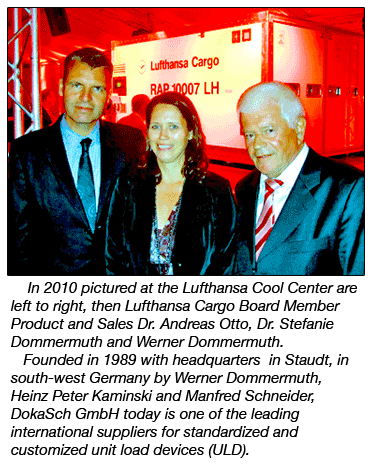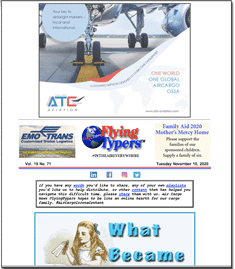Andreas Seitz is the outspoken and at times ebullient Managing Director of DoKaSch. DoKaSch is located about an hour from Frankfurt Airport in Montabaur,
a picturesque German village with a big yellow Castle looking over the town.
DoKaSch has been in the container business
for more than 30 years and in temperature controlled solutions since 2013.
The company says that has it just what
you are looking for in Pharma Transit 2020.
The
company also operates a big container station for its containers, including
its popular Opticooler in a place called Kelsterbach, which is just a stone’s
throw away from Frankfurt Am Main’s main runways. Kelsterbach is a
made up airport town with a couple of good restaurants.
“Like
everyone in the air cargo sector,” Andreas told FT, “the
pandemic and its impact came as a shock and we were confronted with many
unexpected problems.
“The
reduced and unstable global flight network, especially with the breakdown
of belly freight capacities, was a big challenge. It made any kind of transport
more complicated because even urgent deliveries could not always be accommodated
and it was sometimes hard to re-position empty containers.
“At
the same time, the demand for active temperature-regulated transport solutions
was rising. While this was good news for us, it was still a challenge because
of the heavily reduced air cargo capacities.
“However, due to the great collaboration
and commitment of our partners, our agile internal processes and our spare
stock, we managed to face these challenges and adapted to the unusual situation
quickly.”
 The
Challenge Right Now The
Challenge Right Now
“We are focusing on our Opticooler.
“From what we know currently,
most of the vaccines will require temperature-regulated transports, many
in the range between 2 °C and 8 °C, which is what the Opticooler
is designed for.
“Even under extreme conditions
at varying between very low and very high temperatures, it keeps the cargo
very well within the 2 °C to 8 °C temperature range.
“Opticooler is quickly available
because it can be configured with the simple push of a button and is available
at different locations around the world.
“The Opticooler program offers
the highest quality and reliability, and there is no better technology
today than active/rechargeable containers to manage the many uncertainties
of the global cool chain.”
Core Competence
“We at DoKaSch focus on air
cargo ULDs only, which is our core competence for 30 years.
“We will not step into non-ULD
passive boxes, since Opticooler RAP uses the given lower deck capacity
of an aircraft to the maximum with 5 euro / 4CP1 on one pallet space.
“Developing a special solution
for e.g. for minus 40°C or minus 80 °C would be too late for the
current vaccine peak, and may not be needed after the vaccine campaigns.
“However, we are still adapting
and optimizing our internal processes to ensure the high availability
of the Opticooler in these challenging times.”
Can Air Cargo
Handle The Vaccine Rush?
“IATA,” Andreas Seitz declared, “recently
estimated that 8,000 jumbo jets will be necessary to transport all the
vaccines.
“This shows the scope of the
challenge we will have to face.
“Probably all of these transports
will require temperature-controlled transport solutions. While many of
these are in the +2 °C to +8 °C range, some will even require
temperatures around -80 °C. These in particular will pose the real
challenge.
“We learn more every day about
what will be considered necessary for the transport, but the capacities
are still limited. The vaccine transports will probably occur together
with a recovery of the global economy, while intercontinental passenger
flights will not return into service at the same speed.
“In turn, the belly capacity
will be quite limited, and there will be capacity shortages. However,
we are certain that air cargo is preparing itself properly for what is
to come.
“The upcoming situation is difficult,
but manageable if everyone along the supply chain acts responsibly.
“It is crucial that everyone,
from pharma producers to airlines, cooperate in every single stage of
the transportation cycle.
“Close cooperation over the
entire cool chain is the prime directive. Since the number of packaging
solutions – by all suppliers - is limited, a turnaround time as
short as possible and a secure re-positioning of assets may become key.
“For example, containers must
be unloaded as soon as possible upon arrival to be returned empty on the
same charter aircraft.”
What Surprises
You?
“Aside from the total and sudden
breakdown of air cargo capacities, I was pleasantly surprised by the resilience
of the air cargo industry and the fast ability to adapt.
“Air cargo quickly managed to
reorganize itself and focused on priority transports like pharma.
“The way all stakeholders worked
together and established new solutions was astonishing.
“This also includes the responsible
aviation authorities.
“Everyone knew what was at stake,
and the collaboration between airlines, forwarders and authorities was
quick and efficient.
“Instead of slow bureaucratic
reaction, new procedures and solutions were established in a rather short
amount of time.
“The best example for this of
course was the development of the ‘preighters’”.
Air Cargo
Reacting Swiftly To The Challenge
Airlines around the world quickly
started converting their passenger planes to handle the demand despite
reduced capacity, in particular for live-saving medicines.
“Over the last couple of years,
the climate for cool chain has markedly improved as the stakeholders became
much more aware of the importance and requirements of cool chain transport.
“As always, there is room for
further improvements.
“Several aspects of the cool
chain are still quite manual, and every packaging solution - active as
well as passive - needs certain and specific care.
“Airlines must comply 100 percent
with their operational procedures, in particular for temperature-controlled
shipments.
“This is, and will be a challenge
without enhancing digitalization.
“This requires not only full
transparency about the shipment and the specific conditions at all times,
but also the ability to take immediate corrective action to avoid a temperature
deviation, if there is a deviation to the SOP detected during transport.”
The Flying Cool Warehouse
The DoKaSch Opticooler promise: Expect
highest reliability and availability, combined with biggest volume (means
lowest air cargo costs per pallet) plus easy access.
“The Opticooler serves as a
flying cool warehouse, protecting the most temperature sensitive and risky
cargo at any climate and any temperature and with almost unlimited runtime
(compared to passive solutions).”
Geoffrey
|




